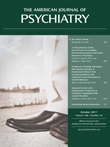fMRI Correlates of White Matter Hyperintensities in Late-Life Depression
Abstract
Objective:
This study tests whether or not the structural white matter lesions that are characteristic of late-life depression are associated with alterations in the functional affective circuits of late-life depression. This study used an emotional faces paradigm that has been shown to engage the affective limbic brain regions.
Method:
Thirty-three elderly depressed patients and 27 nondepressed comparison subjects participated in this study. The patients were recruited through the NIMH-sponsored Advanced Center for Interventions and Services Research for the Study of Late-Life Mood Disorders at the University of Pittsburgh Center for Bioethics and Health Law. Structural and functional MRI was used to assess white matter hyperintensity (WMH) burden and functional magnetic resonance imaging (fMRI) blood-oxygen-level-dependent (BOLD) response on a facial expression affective-reactivity task in both elderly participants with nonpsychotic and nonbipolar major depression (unmedicated) and nondepressed elderly comparison subjects.
Results:
As expected, greater subgenual cingulate activity was observed in the depressed patients relative to the nondepressed comparison subjects. This same region showed greater task-related activity associated with a greater burden of cerebrovascular white matter change in the depressed group. Moreover, the depressed group showed a significantly greater interaction of WMH by fMRI activity effect than the nondepressed group.
Conclusions:
The observation that high WMH burden in late-life depression is associated with greater BOLD response on the affective-reactivity task supports the model that white matter ischemia in elderly depressed patients disrupts brain mechanisms of affective regulation and leads to limbic hyperactivation.



